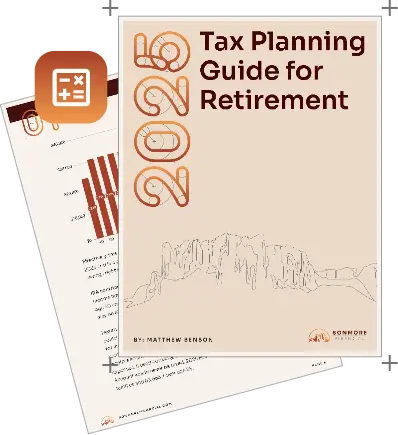Table of contents
Jim and Linda, a retired couple from Chandler, were excited to start their golden years. For decades, they worked hard and saved diligently. With retirement approaching, they counted down to sunny vacations and a slower pace.
But in their first tax season as retirees, they faced a tax bill much higher than they’d planned ahead for.
The reason? They withdrew a large sum from their traditional IRA for living expenses — increasing their taxable income, pushing them into a higher tax bracket, and raising their Medicare premiums.
Many retirees unknowingly pay more in taxes than necessary due to inefficient withdrawal strategies. But there’s good news: with proper planning, you may be able to reduce your tax burden and make your lifelong savings last even longer.
How do withdrawals impact my taxes?
Different types of retirement accounts are bound by different tax rules. It’s important to have a grasp of the basic rules of the game so you can strategize.
Withdrawals from Traditional IRAs and 401(k) accounts are taxed as ordinary income.
Example: Imagine a retiree from Scottsdale who saved her whole life. Contributions to her employer-provided 401(k) always came out “pre-tax” — she didn’t pay any taxes at the time. She’ll need to pay income tax on that money in the year she withdraws it.
Roth IRAs & Roth 401(k)s are different. With these accounts, contributions are made from “after tax” dollars, but generally are tax-free on withdrawal, if qualified distribution rules are met.
Example: A worker in Glendale withholds part of his salary from every paycheck for income taxes. He invests some of his take-home pay — that is, after tax dollars — into a Roth retirement account. When he retires and withdraws from his Roth accounts, he won’t have to pay additional taxes on that money.
Finally, Taxable Investment Accounts are another option. Depending on the holding period, withdrawals may be subject to capital gains tax.
Why taxes matter in retirement
It doesn’t matter how much of a patriot you are: nobody likes paying more in taxes than they need to.
This is doubly true for retirees, who need to be confident in their finances on a fixed income, while enjoying the lifestyle they’ve worked so hard for.
With Jim and Linda above, we’ve already seen how large withdrawals can push you into a higher tax bracket, increasing your overall tax obligation.
But there are other factors that can impact your tax liability and what it means for your monthly budget.
Depending on your overall income, up to 85% of your Social Security benefits could be taxable. And if your income reaches a certain threshold, you could be on the hook for Medicare premium increases, too.
These taxes and surcharges aren’t catastrophic, but why not maximize your savings? After all, you saved for a lifetime to enjoy playing with grandkids and pursuing hobbies — not to pad Uncle Sam’s pockets.
Three strategies for tax-smart withdrawals
Retirees have a few options to withdraw their money while staying strategic about the tax liability. Here are a few:
1. The Bracket Balancer: Controlling your taxable income
This strategy involves managing withdrawals to remain in lower tax brackets. Approaches include:
- Withdrawing just enough from tax-deferred accounts to stay within a lower tax bracket.
- Using Roth conversions strategically in lower-income years to move funds into tax-free accounts.
- Delaying Social Security benefits to reduce taxable income in early retirement.
For example, a retiree in Mesa with a mix of traditional and Roth IRA funds might withdraw from their traditional IRA — remember, this is taxed as normal income — just enough to remain within the 12% tax bracket. Additional expenses could be covered with Roth IRA withdrawals, which are generally tax-free.
2. The Bucket List: Tax diversification for smart withdrawals
We believe a well-diversified approach to withdrawals can help manage tax liability over time:
- Bucket 1: Taxable Accounts – Used first, as long-term capital gains rates are often lower.
- Bucket 2: Tax-Deferred Accounts – Withdraw strategically to manage tax brackets.
- Bucket 3: Tax-Free Accounts (Roth IRAs) – Preserved for later years or unexpected expenses.
A retiree in Gilbert followed this strategy by funding early retirement years with taxable investments, delaying IRA withdrawals until required minimum distributions (RMDs) began, and minimizing their tax burden while allowing tax-deferred investments to grow.
3. Roth Conversions: Long-term tax reduction strategy
Potential Benefits:
- Reduces future required minimum distributions (RMDs), lowering taxable income later in retirement.
- Allows for tax-free growth and withdrawals in high-tax years.
- Pays taxes now at potentially lower rates instead of later at higher rates.
When to Consider Converting:
- In early retirement when taxable income is lower.
- Before RMDs begin at age 73.
- During market downturns to maximize tax efficiency.
By converting portions of a traditional IRA to a Roth IRA over several years, a retiree in Queen Creek may reduce future RMD burdens and increase tax-free income later in retirement.
Avoid these three common mistakes
1. Not taking RMDs when required
RMDs are mandatory withdrawals from tax-deferred accounts starting at age 73. Failing to take an RMD on time incurs a penalty of up to 25% of the required amount (or 10% if corrected promptly). To avoid this:
- Work with a financial professional to calculate RMDs.
- Set up automated withdrawals to ensure compliance.
2. Overlooking tax-efficient charitable giving
Qualified Charitable Distributions (QCDs) allow individuals aged 70½ and older to donate directly from an IRA to a qualified charity. Even the most generous among us overlook this option, choosing to write a check when there are more advantageous options.
Beyond the inherent benefits of supporting causes important to you, this move can potentially reduce your taxable income and satisfy RMD requirements.
3. Selling investments without considering tax consequences
Selling investments without a tax strategy can lead to an unnecessary capital gains tax burden. Consider:
- Tax-loss harvesting to offset gains.
- Strategic timing of sales to minimize tax impact.
Your next steps: How to create a personalized plan
The most tax-efficient withdrawal strategies are tailored to each retiree’s unique financial situation. Factors such as income sources, investment mix, and long-term goals should be considered.
A smart withdrawal strategy can add years to your savings. Work with a financial professional to ensure you’re making the most of your retirement income.
Disclosure
This content is for informational purposes only and should not be considered tax, legal, or financial advice. Consult a qualified financial professional before making any investment or tax-related decisions.
Advisory services are offered through Sonmore Financial LLC, an Investment Advisor in the State of Arizona. This material represents an assessment of the market environment at a specific point in time and is not intended to be a forecast of future events, or a guarantee of future results. This information should not be relied upon by the reader as research or investment advice regarding any funds or stocks in particular, nor should it be construed as a recommendation to purchase or sell a security. Past performance is no guarantee of future results. Investments will fluctuate and when redeemed may be worth more or less than when originally invested.


